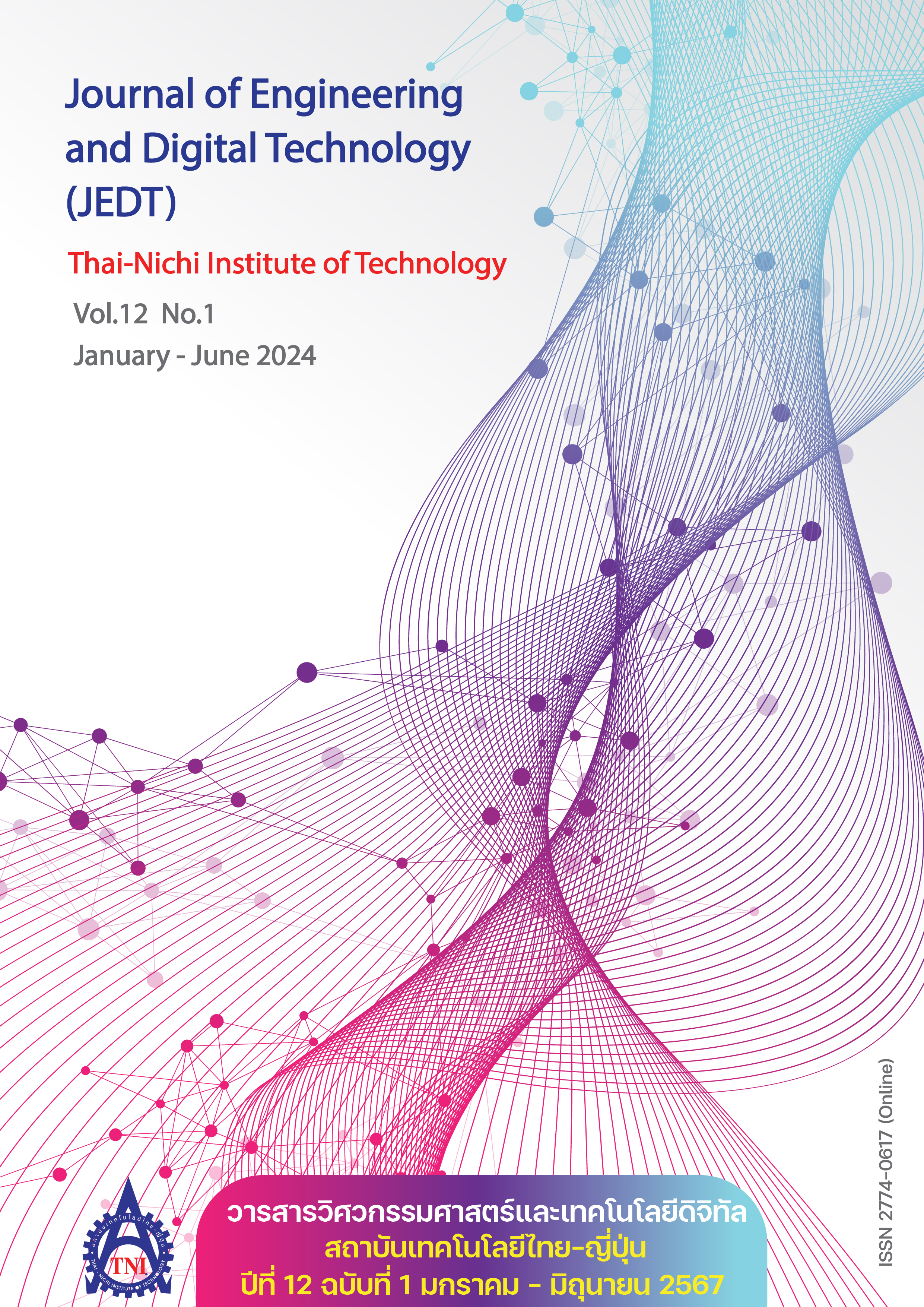Monitoring Blood Coagulation Behavior Using Quartz Crystal Microbalance with a Mason Equivalent Circuit Model
Main Article Content
บทคัดย่อ
Blood clotting ability is a vital function of life forms, aiding survival when the body sustains cuts or wounds. Patients lacking this ability, or those on blood-thinning medications, can suffer from excessive bleeding, posing challenges for medical treatment. This is particularly relevant for dentists, as excessive bleeding may occur during tooth extractions or other dental procedures. Hence, there is a need for real-time blood coagulation detection. We propose using the quartz crystal microbalance (QCM) as a sensor. Its ability to detect mass loading and viscosity makes it feasible for coagulation testing in dental clinics. However, conventional equations like Sauerbrey’s and Kanazawa’s do not account for the dissipation factor, which plays a crucial role in determining liquid viscosity. We suggest using the Mason equivalent circuit model for interpreting blood viscosity and its clotting on the QCM surface. Observations show that film thickness increases with viscosity. Different samples exhibited varying viscosity changes, while the increase in film thickness was relatively comparable. This demonstrates the potential of the Mason equivalent Circuit model to differentiate results and estimate the underlying physical properties of blood coagulation.
Article Details

อนุญาตภายใต้เงื่อนไข Creative Commons Attribution-NonCommercial-NoDerivatives 4.0 International License.
นโยบายการรับบทความ
กองบรรณาธิการวารสารสถาบันเทคโนโลยีไทย-ญี่ปุ่น มีความยินดีรับบทความจากอาจารย์ประจำ และผู้ทรงคุณวุฒิในสาขาวิศวกรรมศาสตร์และเทคโนโลยี ที่เขียนเป็นภาษาไทยหรือภาษาอังกฤษ ซึ่งผลงานวิชาการที่ส่งมาขอตีพิมพ์ต้องไม่เคยเผยแพร่ในสิ่งพิมพ์อื่นใดมาก่อน และต้องไม่อยู่ในระหว่างการพิจารณาของวารสารอื่นที่นำส่ง ดังนั้นผู้สนใจที่จะร่วมเผยแพร่ผลงานและความรู้ที่ศึกษามาสามารถนำส่งบทความได้ที่กองบรรณาธิการเพื่อเสนอต่อคณะกรรมการกลั่นกรองบทความพิจารณาจัดพิมพ์ในวารสารต่อไป ทั้งนี้บทความที่สามารถเผยแพร่ได้ประกอบด้วยบทความวิจัย ผู้สนใจสามารถศึกษาและจัดเตรียมบทความจากคำแนะนำสำหรับผู้เขียนบทความ
การละเมิดลิขสิทธิ์ถือเป็นความรับผิดชอบของผู้ส่งบทความโดยตรง บทความที่ได้รับการตีพิมพ์ต้องผ่านการพิจารณากลั่นกรองคุณภาพจากผู้ทรงคุณวุฒิและได้รับความเห็นชอบจากกองบรรณาธิการ
ข้อความที่ปรากฏภายในบทความของแต่ละบทความที่ตีพิมพ์ในวารสารวิชาการเล่มนี้ เป็น ความคิดเห็นส่วนตัวของผู้เขียนแต่ละท่าน ไม่เกี่ยวข้องกับสถาบันเทคโนโลยีไทย-ญี่ปุ่น และคณาจารย์ท่านอื่น ๆ ในสถาบัน แต่อย่างใด ความรับผิดชอบด้านเนื้อหาและการตรวจร่างบทความแต่ละบทความเป็นของผู้เขียนแต่ละท่าน หากมีความผิดพลาดใด ๆ ผู้เขียนแต่ละท่านจะต้องรับผิดชอบบทความของตนเองแต่ผู้เดียว
กองบรรณาธิการขอสงวนสิทธิ์มิให้นำเนื้อหา ทัศนะ หรือข้อคิดเห็นใด ๆ ของบทความในวารสารสถาบันเทคโนโลยีไทย-ญี่ปุ่น ไปเผยแพร่ก่อนได้รับอนุญาตจากผู้นิพนธ์ อย่างเป็นลายลักษณ์อักษร ผลงานที่ได้รับการตีพิมพ์ถือเป็นลิขสิทธิ์ของวารสารสถาบันเทคโนโลยีไทย-ญี่ปุ่น
ผู้ประสงค์จะส่งบทความเพื่อตีพิมพ์ในวารสารวิชาการ สถาบันเทคโนโลยีไทย-ญี่ปุ่น สามารถส่ง Online ที่ https://www.tci-thaijo.org/index.php/TNIJournal/ โปรดสมัครสมาชิก (Register) โดยกรอกรายละเอียดให้ครบถ้วนหากต้องการสอบถามข้อมูลเพิ่มเติมที่
- กองบรรณาธิการ วารสารสถาบันเทคโนโลยีไทย-ญี่ปุ่น
- ฝ่ายวิจัยและนวัตกรรม สถาบันเทคโนโลยีไทย-ญี่ปุ่น
เลขที่ 1771/1 สถาบันเทคโนโลยีไทย-ญี่ปุ่น ซอยพัฒนาการ 37-39 ถนนพัฒนาการ แขวงสวนหลวง เขตสวนหลวง กรุงเทพมหานคร 10250 ติดต่อกับคุณพิมพ์รต พิพัฒนกุล (02) 763-2752 , คุณจุฑามาศ ประสพสันติ์ (02) 763-2600 Ext. 2402 Fax. (02) 763-2754 หรือ E-mail: JEDT@tni.ac.th
เอกสารอ้างอิง
A. Mujahid, A. Afzal, and F. L. Dickert, “An overview of high frequency acoustic sensors—QCMs, SAWs and FBARs—chemical and biochemical applications,” Sensors, vol. 19, no. 20, p. 4395, Oct. 2019.
G. Sauerbrey, “Verwendung von Schwingquarzen zur Wägung dünner Schichten und zur Mikrowägung,” (in German), Zeitschrift für Physik, vol. 155, no. 2, pp. 206–222. Apr. 1959.
A. Seifner, P. Lieberzeit, C. Jungbauer, and F. L. Dickert, “Synthetic receptors for selectively detecting erythrocyte ABO subgroups,” Analytica Chimica Acta, vol. 651, no. 2, pp. 215–219, Oct. 2009.
P. J. Jandas, K. Prabakaran, J. Luo, and M. G. D. Holaday, “Effective utilization of quartz crystal microbalance as a tool for biosensing applications,” Sensors and Actuators A: Physical, vol. 331, Nov. 2021, Art. no. 113020.
M. Jenik, A. Seifner, P. Lieberzeit, and F. L. Dickert, “Pollen-imprinted polyurethanes for QCM allergen sensors,” Anal. Bioanal. Chem., vol. 394, no. 2, pp. 523–528, Mar. 2009.
M. Jenik et al., “Sensing picornaviruses using molecular imprinting techniques on a quartz crystal microbalance,” Anal. Chem., vol. 81, no. 13, pp. 5320–5326, Jul. 2009.
S. N. Songkhla and T. Nakamoto, “Interpretation of quartz crystal microbalance behavior with viscous film using a mason equivalent circuit,” Chemosensors, vol. 9, no. 1, p. 9, Jan. 2021.
M. Hussain, “Prothrombin Time (PT) for human plasma on QCM-D platform: A better alternative to 'Gold Standard',” Pharmaceutical Biosci. J., vol. 3, no. 6, pp. 1–8, Sep. 2015.
D. Maji et al., “Assessment of whole blood coagulation with a microfluidic dielectric sensor,” J. Thrombosis Haemostasis, vol. 16, no. 10, pp. 2050–2056, Oct. 2018.
O. Cakmak et al., “A cartridge based sensor array platform for multiple coagulation measurements from plasma,” Lab Chip, vol. 15, no. 1, pp. 113–120, Oct. 2015.
D. Chen et al., “Micro-electromechanical film bulk acoustic sensor for plasma and whole blood coagulation monitoring,” Biosensors Bioelectron., vol. 91, pp. 465–471, May 2017, doi: 10.1016/j.bios.2016.12.063.
S. D. Sahli, J. Rössler, D. W. Tscholl, J. D. Studt, D. R. Spahn, and A. Kaserer, “Point-of-care diagnostics in coagulation management,” Sensors, vol. 20, p. 4254, Jul. 2020.
J. Yao et al., “Blood coagulation testing smartphone platform using quartz crystal microbalance dissipation method,” Sensors, vol. 18, no. 9, p. 3073, Sep. 2018.
L. Müller et al., “Investigation of prothrombin time in human whole-blood samples with a quartz crystal biosensor,” Anal. Chem., vol. 82, no. 2, pp. 658–663, Jan. 2010.
M. Hussain, “Ultra-sensitive detection of heparin via aPTT using plastic antibodies on QCM-D platform,” RSC Adv., vol. 5, no. 68, pp. 54963–54970, Jun. 2015.
Y. Yang et al., “Stability enhanced, repeatability improved Parylene-C passivated on QCM sensor for aPTT measurement,” Biosensors Bioelectron., vol. 98, pp. 41–46, Dec. 2017, doi: 10.1016/j.bios.2017.06.021.
W. Pan et al., “Applicability of a sensitivity-enhanced quartz crystal microbalance in analyzing blood plasma viscosity and coagulation,” Sensors Mater., vol. 34, no. 4, pp. 1515–1525, Apr. 2022.
R. Lucklum and P. Hauptmann, “The ∆f–∆R QCM technique: An approach to an advanced sensor signal interpretation,” Electrochim. Acta, vol. 45, no. 22–23, pp. 3907–3916, Jul. 2000.
H. L. Bandey, R. W. Cernosek, W. E. Lee III, and L. E. Ondrovic, “Blood rheological characterization using the thickness-shear mode resonator,” Biosensors Bioelectron., vol. 19, no. 12, pp. 1657–1665, Jul. 2004.
H. L. Bandey, S. J. Martin, R. W. Cernosek, and A. R. Hillman, “Modeling the responses of thickness-shear mode resonators under various loading conditions,” Anal. Chem., vol. 71, no. 11, pp. 2205–2214, Jun. 1999.
K. M. Evans-Nguyen and M. H. Schoenfisch, “Fibrin proliferation at model surfaces: Influence of surface properties,” Langmuir., vol. 21, no. 5, pp. 1691–1694, Mar. 2005.
B. C. Heinze and J.-Y. Yoon, “Real-time monitoring of fibrinogen cross-linking on model biomaterial surfaces with quartz crystal microbalance,” Open Biotechnol. J., vol. 2, no. 1, Nov. 2008.
H. Muramatsu, J. Kim, and S. Chang, “Quartz-crystal sensors for biosensing and chemical analysis,” Anal. Bioanal. Chem., vol. 372, no. 2, pp. 314–321, Jan. 2002.
S. N. Songkhla and T. Nakamoto, “Signal processing of vector network analyzer measurement for quartz crystal microbalance with viscous damping,” IEEE Sens. J., vol. 19, no. 22, pp. 10386–10392, Nov. 2019.


